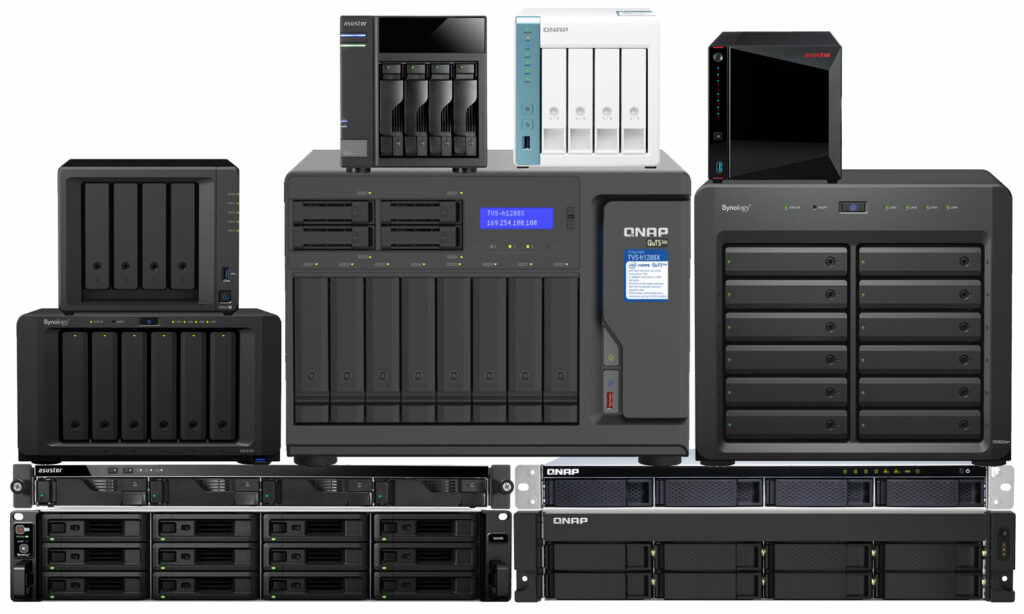What is a NAS System?
NAS systems (Network Attached Storage) can be compared to small, compact servers. They provide users with disk storage over the network, allowing not all data to be stored locally, but rather on a central, large disk storage space. The devices usually have two, or in high-end devices, up to 60 or more hard drives. All devices have a CPU and therefore require RAM. The performance specifications of the CPUs are often in the lower segment. For very inexpensive systems, you often find Pentium, Atom, Annapurna, or Intel I3 CPUs. All devices always have a network connection. Depending on the performance class, one or more 10Gbit network connections can also be installed. The major NAS system providers are QNAP, Synology, ASUSTOR …

What are the benefits of a RAM upgrade in a NAS system?
Every device requires RAM. Compared to the access speeds of an HDD/SSD, RAM is significantly faster. During the boot process of the operating system, a large portion of the RAM pre-installed by the manufacturer is often already in use.
More RAM primarily means that multiple programs/applications can be loaded and executed simultaneously on the device. There is also more memory available for internal processes and services. Free RAM can also be used as cache memory for disk access in a NAS system. This effect leads to a situation-dependent optimization of the operational speed of the NAS system. With more RAM in conjunction with a powerful CPU, virtualization solutions, Docker systems, or complex tasks can be executed on a NAS system.
Using RAM as Cache Memory
In NAS systems, having more RAM can be extremely important, as the free RAM is often used as cache. Caching plays a significant role, especially in the transmission of small data blocks. Many small files are collected in the cache area and transferred with access to the disk controller. This relieves the disk controller, and caching thus contributes to significantly improving the performance of the NAS system.
What can a NAS system be used for?
Depending on configuration and setup, NAS systems have numerous applications that go beyond mere data storage. Here are some examples of how NAS can be effectively used:
NAS as Data Storage
NAS systems in the classic variant provide users with large disk storage over the network. All connected computers, smartphone apps, or smart TVs can instantly access this data via the network. Through folder systems and sharing rules, the provided data can be controlled or restricted.
The NAS system thus serves as a central network storage for data, images, movies, and music.
NAS as Backup System
NAS systems are also very well suited for backups (data backup of an entire PC). For example, backups can be easily and effectively created using free software like Veeam Agent for Microsoft Windows systems. Apple systems can also be easily backed up via Time Machine.
NAS as Docker System
With a powerful CPU and sufficient RAM, the NAS can also be used as a Docker host. With the popular open-source tool Docker, a particularly resource-saving virtualization solution for a variety of different applications is possible. With Docker, for example, so-called containers can be created on the NAS and applications can be run in virtual environments. Docker systems have a minimized operating system and therefore require less processing power than, for example, a “virtual machine.”
NAS for Virtual Machines
To operate a “Virtual Machine” (VM), the NAS should have at least 4 GB, better yet 8 GB or more of RAM. Additionally, the CPU should have at least 2 free CPU cores available for VM use.
This allows the NAS to host multiple virtual machines efficiently.
NAS for Video Surveillance
Manufacturers offer specific NAS systems for video surveillance. These devices typically have the performance necessary to view multiple livestreams simultaneously without delay. However, video surveillance is theoretically possible with any NAS. All that is needed is an IP camera that supports the ONVIF standard. USB webcams cannot be used as cameras. Which camera is right depends on many factors. Compatibility lists show which camera has been tested with which NAS by the manufacturer.
